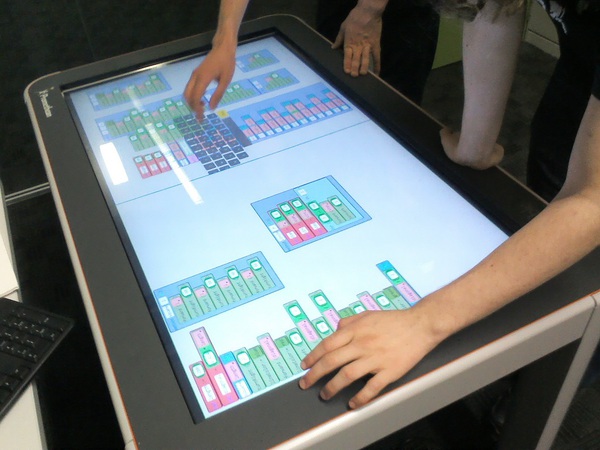Learning to programme: To touch or not to touch?
30 Nov 2017 - 09:43:00 in Research
 A Computer Science student has explored the potential of using interactive touch tables to teach programming compared to traditional mouse and keyboard versions, fulfilling a long-held aspiration to investigate how people learn best.
Master’s student Ben Selwyn-Smith, who cites a keen interest in education, found that the benefits of the new approach include the ability for multiple users to code at the same time, something which was previously impossible.
For these purposes, a visual, block-based programming language called Tabletop Grace was used, an extension from an existing mouse and keyboard block language called Tiled Grace. Block-based languages, including one called Scratch, have previously been used to teach children how to code, as they provide an easy way to create games and animations with no syntax errors.
“The main motivation behind this project was to combine block-based programming with pair programming, where two people can code at the same time, and also with interactive touch tables,” explains Ben. “Research has shown that each of these is individually worthwhile, but combinations of all three did not exist.”
Previously, pair programming with block languages was typically done either with two individuals sharing one single-user device, or two devices with remote collaboration, whereas using an interactive touch table allows users to collaborate from the same location.
“This project is great in that I got to combine software development and design with research, including experience in conducting that research, formal presentations and software demonstrations,” Ben continues. “I now feel much more prepared for future endeavours—if I decide to pursue a career in programming or research I have a good grounding in both.”
Ben also enjoyed working with his two supervisors from Victoria’s School of Engineering and Computer Science: Dr Craig Anslow, with his extensive knowledge of interactive touch tables, and Dr Michael Homer, the creator of Tiled Grace, the block-based language that formed the basis of Ben’s new software, Tabletop Grace.
“Getting to work alongside my supervisors was great, as well as being a collaborator on a paper that was accepted by the Blocks and Beyond 2017 Workshop,” says Ben. “Tabletop Grace was considered to be as usable as Tiled Grace, so the transition to touch tables was successful. Also, 70 percent of participants in my user study said they preferred working on the tabletop, as it was less frustrating and more enjoyable, intuitive and novel.”
Ben credits Victoria’s 24-hour access computer labs with keeping him on task during the project.
“The coolest thing about being an student at Victoria is that if I feel like coming in and doing some work at 4am, I can!” he says. “Also living in Wellington, everything I need is within easy walking distance, which keeps me healthy despite long hours working at a computer.”
“As I did a second major in Japanese at undergraduate level, my dream job would be somewhere where I can combine my language skills with computer science, either here or in Japan.”
A Computer Science student has explored the potential of using interactive touch tables to teach programming compared to traditional mouse and keyboard versions, fulfilling a long-held aspiration to investigate how people learn best.
Master’s student Ben Selwyn-Smith, who cites a keen interest in education, found that the benefits of the new approach include the ability for multiple users to code at the same time, something which was previously impossible.
For these purposes, a visual, block-based programming language called Tabletop Grace was used, an extension from an existing mouse and keyboard block language called Tiled Grace. Block-based languages, including one called Scratch, have previously been used to teach children how to code, as they provide an easy way to create games and animations with no syntax errors.
“The main motivation behind this project was to combine block-based programming with pair programming, where two people can code at the same time, and also with interactive touch tables,” explains Ben. “Research has shown that each of these is individually worthwhile, but combinations of all three did not exist.”
Previously, pair programming with block languages was typically done either with two individuals sharing one single-user device, or two devices with remote collaboration, whereas using an interactive touch table allows users to collaborate from the same location.
“This project is great in that I got to combine software development and design with research, including experience in conducting that research, formal presentations and software demonstrations,” Ben continues. “I now feel much more prepared for future endeavours—if I decide to pursue a career in programming or research I have a good grounding in both.”
Ben also enjoyed working with his two supervisors from Victoria’s School of Engineering and Computer Science: Dr Craig Anslow, with his extensive knowledge of interactive touch tables, and Dr Michael Homer, the creator of Tiled Grace, the block-based language that formed the basis of Ben’s new software, Tabletop Grace.
“Getting to work alongside my supervisors was great, as well as being a collaborator on a paper that was accepted by the Blocks and Beyond 2017 Workshop,” says Ben. “Tabletop Grace was considered to be as usable as Tiled Grace, so the transition to touch tables was successful. Also, 70 percent of participants in my user study said they preferred working on the tabletop, as it was less frustrating and more enjoyable, intuitive and novel.”
Ben credits Victoria’s 24-hour access computer labs with keeping him on task during the project.
“The coolest thing about being an student at Victoria is that if I feel like coming in and doing some work at 4am, I can!” he says. “Also living in Wellington, everything I need is within easy walking distance, which keeps me healthy despite long hours working at a computer.”
“As I did a second major in Japanese at undergraduate level, my dream job would be somewhere where I can combine my language skills with computer science, either here or in Japan.”
